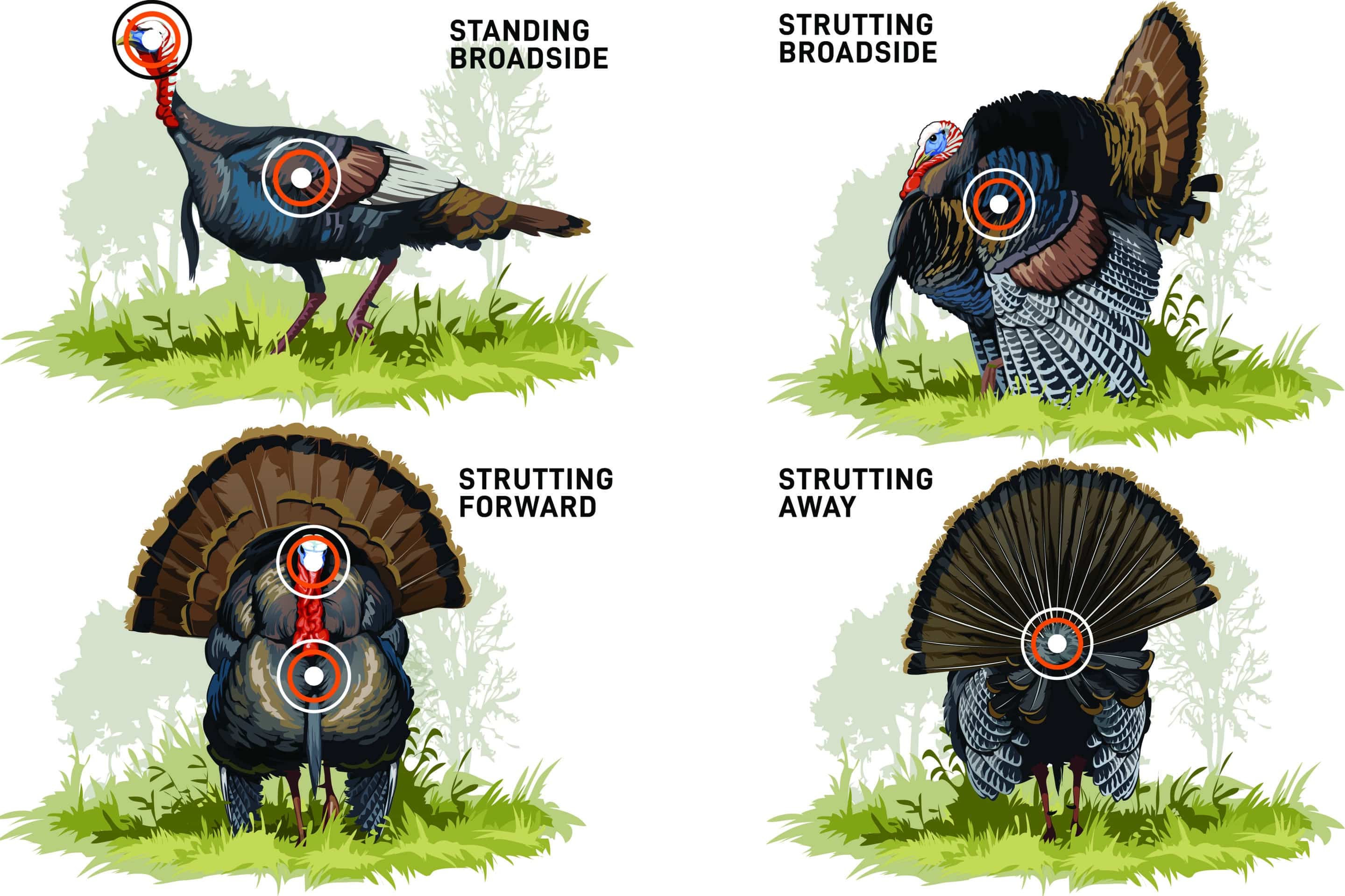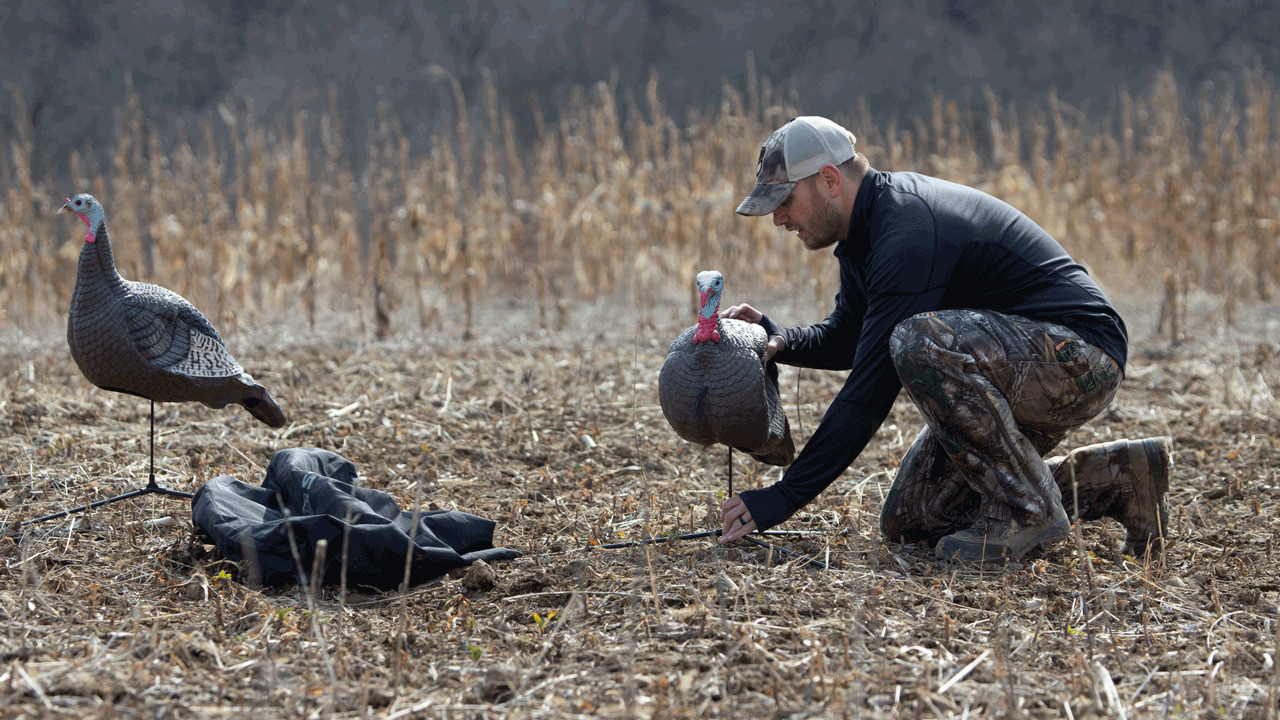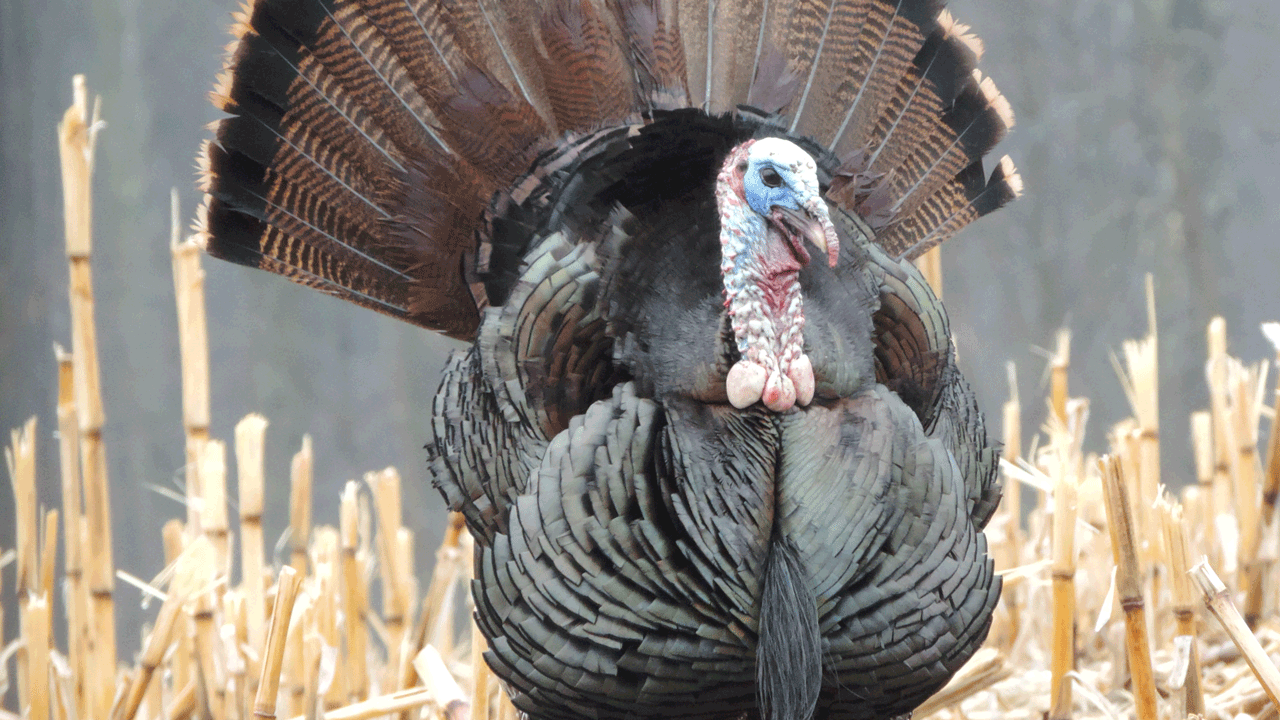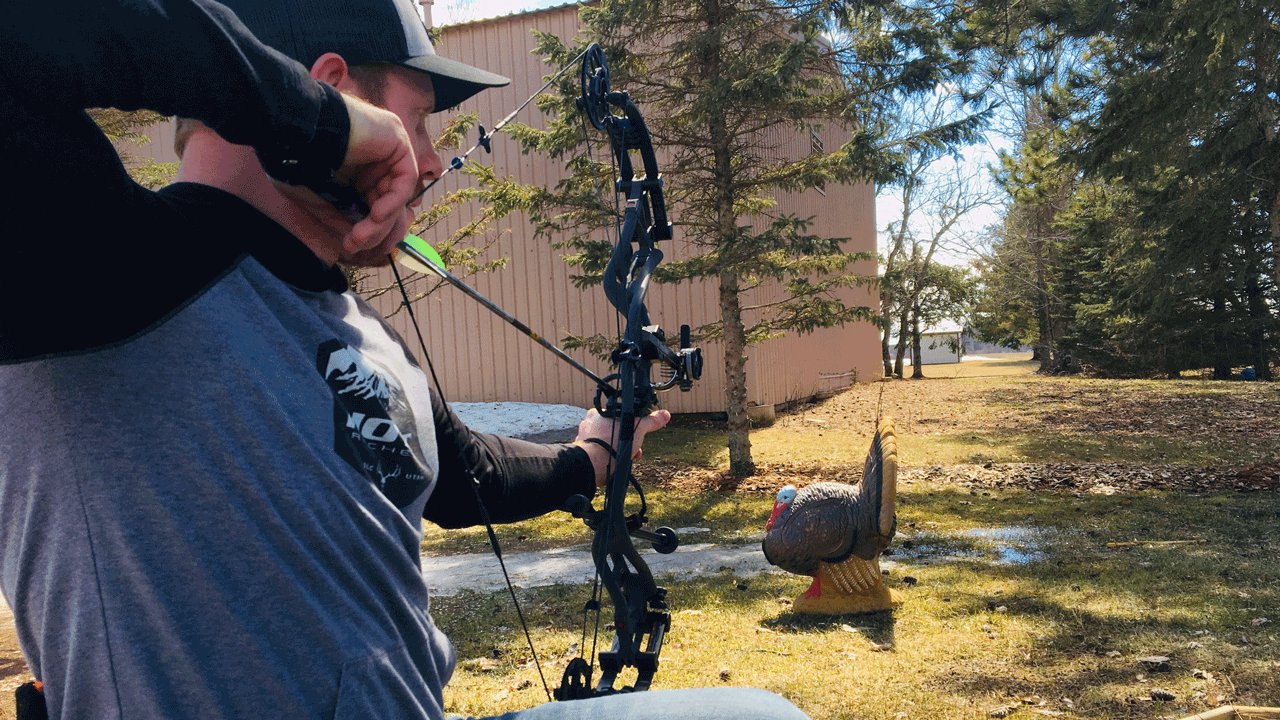I’ve been bowhunting turkeys for 17 years now. In addition to bow-bagging dozens myself, I’ve shared many successful hunts with others, and I’ve even mentored a few folks to their first archery turkeys. I’m not boasting, just pointing out that I’ve seen it all. I’ve watched arrows whizz past toms. I’ve seen arrows dump them on the spot. I’ve seen arrowed turkeys take flight. And, I’ve witnessed everything in between.
Make no mistake, shooting turkeys with a bow and recovering them quickly isn’t always how it goes. A turkey’s softball-sized vitals are difficult to hit, and if you miss them, you’ll likely be faced with floating feathers and a perplexing tracking mission. Following up wounded turkeys can be very difficult, plus it’s a disgusting feeling, especially if the opportunity should’ve been a slam dunk in the first place.
That’s why I want to share six steps you can follow to increase your accuracy when a big bird struts next to your decoys. Let’s take a closer look at how to kill a turkey with a bow.
Shooting a turkey with a bow requires precision patience and knowledge of turkey anatomy. While using a shotgun on turkeys is straightforward, bowhunting turkeys can be more challenging. You need to know exactly where to place your shot on a turkey’s small vital areas.
In this comprehensive guide, I’ll cover everything you need to know about bowhunting turkeys, from shot placement to gear and tips from expert turkey hunters. Whether you’re a beginner looking to bag your first tom or an experienced archer hoping to perfect your technique read on to become a better bowhunter.
Shot Placement on Turkeys
Shot placement is by far the most important factor in effectively and ethically harvesting a turkey with archery equipment. Their vitals are small and angled shots are common, so you must know exactly where to aim.
Front-Facing Shot
When a turkey is facing you head-on, aim for the center of the chest just above the beard. This will drive your arrow through the breastbone and into the vital organs. The beard gives you a clear visual reference point on exactly where to position your shot.
If the bird is in full strut, some archers prefer to aim an inch or two higher to target the throat and spine for an instant kill. Just don’t aim too high or you’ll sail over the tom’s head.
Broadside Shot
The best broadside shot on a turkey is aimed at the wing butt – the area where the wing meets the body. Picture an imaginary line extending straight down from the legs to find your vertical point of reference. Then aim horizontally about halfway up the turkey’s body in line with that.
You can also aim for the dark triangle formed by the turkey’s neck, chest, and wing feathers in full strut. Other options are the base of the wing itself or right in the armpit area.
Quartering-Away Shot
Aim a little below the base of the tail feathers on a turkey facing away from you at an angle. This takes out the spine and vital organs for a lethal shot. The vent area where the tail meets the body is the specific aim point.
Head and Neck Shots
Head and neck shots require pinpoint accuracy but result in an instant kill if executed perfectly. Aim for the turkey’s ear hole or just below its head where the neck meets the body. The jugular vein, spine, and other major blood vessels run through this area.
Avoid the Legs and Wings
Never take a shot at a turkey’s legs or wings. These non-vital hits will lead to a wounded bird you may not recover. Stick to aiming at the body core and neck area only.
Best Gear for Bowhunting Turkeys
Having the right bowhunting gear ups your odds of success:
-
Compound Bow or Crossbow: Both allow for accurate, lethal shots on turkeys within archery range. Match your draw weight to your strength and shooting form.
-
Blinds: Ground blinds conceal movement for close shots. Natural blinds like brush piles also work well when situated properly.
-
Decoys: Realistic hen or jake decoys draw in and distract toms so you can draw undetected.
-
Arrows: Use light arrows like 400-grain matched to your draw length for flat, fast shots.
-
Broadheads: Mechanical heads with 2-inch cutting diameter retain velocity better than fixed blades.
-
String Silencers: Prevent noises that could alert sharp-eared turkeys when you draw and release.
Expert Tips and Tactics
Follow these pro tips from experienced turkey bowhunters when going after spring gobblers:
-
Scout and set up near roosting trees. Calling in Toms from their roost early is effective.
-
Use a popup blind and natural vegetation to conceal movement. Remain still when turkeys are close.
-
Sit all day if needed. Have food, water, and supplies to stay put until prime time.
-
Be patient and allow birds to fully commit before shooting. Rushing your shot often leads to misses or poor hit placement.
-
Practice various shots at multiple angles on a turkey target. This will make proper shot execution second nature.
-
Only take shots within your effective range. Know your limits and resist further temptations.
-
Use a sharp, fixed blade for close range shots. Mechanical broadheads shine at longer distances.
-
Aim low on a turkey’s neck and high on their body. This compensates for ducking and strutting.
FAQs about Shooting Turkeys with a Bow
Here are answers to some commonly asked questions about bowhunting turkeys:
What is the effective range for shooting a turkey with a bow?
Most experts recommend limiting archery shots on turkeys to 20 yards or less, with 15 yards ideal. Shots beyond this greatly reduce accuracy and lethality.
Where should you aim on a turkey with a crossbow?
The same vital areas apply. Aim for the chest at the base of the neck, the wing butt, or just below the head. Avoid the small head and neck to allow room for error.
What broadhead is best for turkey hunting?
Mechanical broadheads with a 2-inch cutting diameter are ideal. They fly true while inflicting massive damage to turkeys. Popular options include the G5 Montec and Rage Trypan NC.
How do you lead a running turkey with a bow?
You should not attempt to shoot a running turkey with archery equipment. Wait for them to pause or turn broadside for an ethical, clean shot.
What size arrow is best for turkey hunting?
Light arrows around 400 grains matched to your draw length give you the flat trajectory and kinetic energy needed to hunt turkeys within bow range.
Ready to Bowhunt Spring Gobblers?
There you have it – everything you need to know to successfully take a bearded turkey with archery gear. Follow the tips outlined here on proper shot placement, gear selection, and hunting strategies. With some practice honing your shooting skills on a turkey target, you’ll be ready to hit the woods and start filling those turkey tags. Just remember to be patient and wait for the ideal shot angle and distance. Wishing you the best of luck this turkey season!

Put the Decoys Closer
In the shuffle of setting up on a gobbling bird, it’s easy to place decoys in a poor spot or too far away. I don’t care how good your shooting skills are; there’s no sense in making a small target smaller. Put decoys at slam-dunk range and where you can comfortably shoot to them.
For distance, I place my decoys at 15 yards if hunting without a blind. When hunting from a ground blind, I like them even closer since I’m not worried about getting drawn. About 8-10 yards is money. I can and have killed toms much, much farther, but why put decoys at 25 yards when you can put them at 10 yards? I want to orchestrate a shot opportunity I can’t screw up.
Placing decoys at 10 yards or closer, however, can cause accuracy problems. Don’t worry. I’ll address that in step 5.

A strutting tom is deceivingly huge. Take away all those feathers and little is left. Take the large breast meat away and there’s less yet. For that reason, aiming small is a chief factor in placing your arrow perfectly.
I made the mistake multiple times early in my turkey-hunting days (and a handful of times since) where I aimed at the bird and not for a specific spot. It’s possible to get lucky and pinwheel a gobbler, but more often a lack of aiming yields a run-away or fly-away result. It’s the biggest hero-to-zero moment you’ll ever experience in the turkey woods.
Again, turkey kill zones are small targets, which is why you must not throw your pin center mass and cut an arrow loose. Instead, study this Turkey Shot Placement article from our friends at Mathews. Know where the vitals are and then aim small. This brings us to another important consideration to the aiming equation.
Unlike a whitetail, a gobbler can be ethically arrowed at any angle with a good bow-arrow-broadhead combination. The problem is that a strutting gobbler and his ever-shifting fan can portray deceiving poses. As a result, folks tend to aim toward the center of the bird, which can sometimes net a nothing-but-breast hit. Recovering a breast-hit bird is rare.
Again, refer to the Turkey Shot Placement article. Take an extra second or two to determine the exact angle at which the bird is standing, and then visualize where the vitals are in relation to that angle. Don’t shoot until you do that. You’ll make better shots.

I can’t count how many turkey hunts I’ve been involved with where the hunter (sometimes it was me) took the shot as soon as the tom arrived in the decoys. If you’ve been following him with your pin the entire way in and have it locked on the vitals, then no problem. However, some folks shoot fast because of the excitement the situation generates. A gobbling, spitting-and-drumming and decoy-pummeling bird creates a false sense of urgency to shoot. In reality, if he’s bought your decoy setup, you practically have all the time in the world. Slow down and take your time.
The other thing I’ve noticed — particularly while using a jake decoy — is that toms coming in for a fight will maul and jump all over the decoy in an epic blur of feathers. Each time they pause, it becomes tempting to shoot right away, but it’s wiser to let them calm down a bit before you attempt the shot. Shooting at a rapidly moving gobbler can easily yield a poor hit or a miss.
Don’t shoot until everything feels right and the bird is holding still. Breathe deeply, focus on the shot and remember: it’s just a bird. Settle down, slow down and make it count.
Practice at Close Range
As I said earlier, we’ll now address the matter of shooting at turkeys at less than 10 yards. Too many bowhunters (I’ve done it in the past, too) use their top pin when a bird comes in close. What results is often a low breast hit. I even know a guy who missed a turkey entirely at 2 yards. At that close range, your arrow doesn’t reach a trajectory that corresponds with your top pin (every bow setup varies).
So as funny as it sounds, you’ll have to practice at distances from 2 to 10 yards and find out where to hold. I aim with my 50-yard pin when birds are 2-5 yards away to hit the mark.

